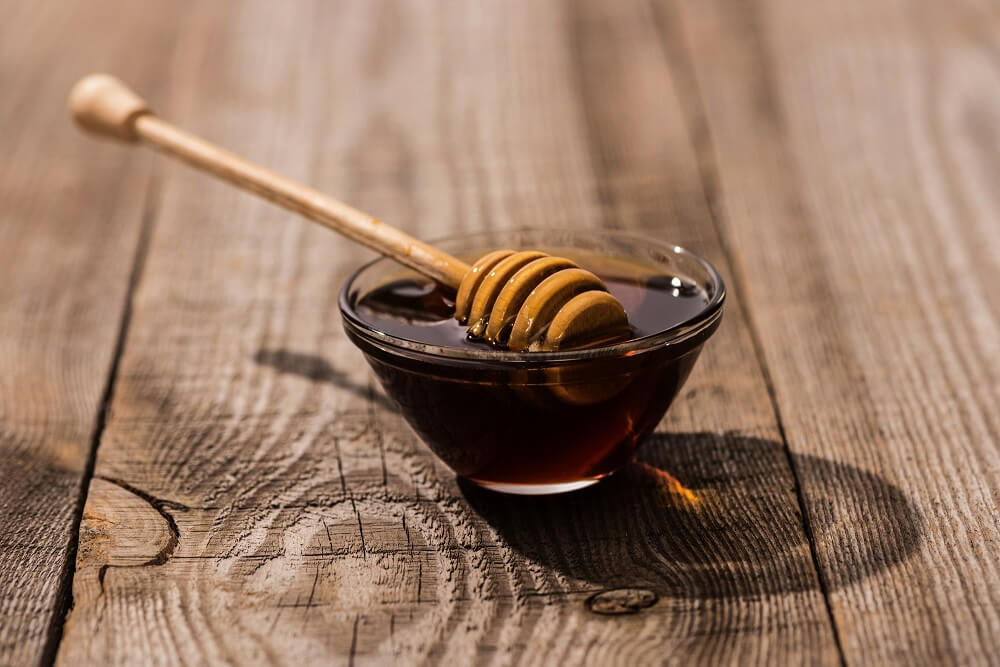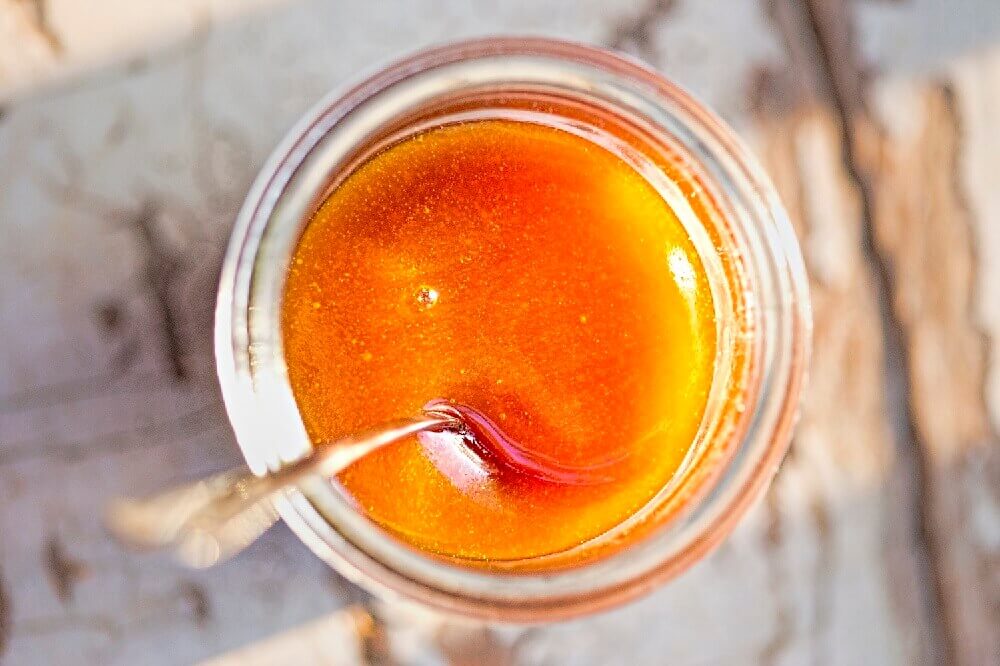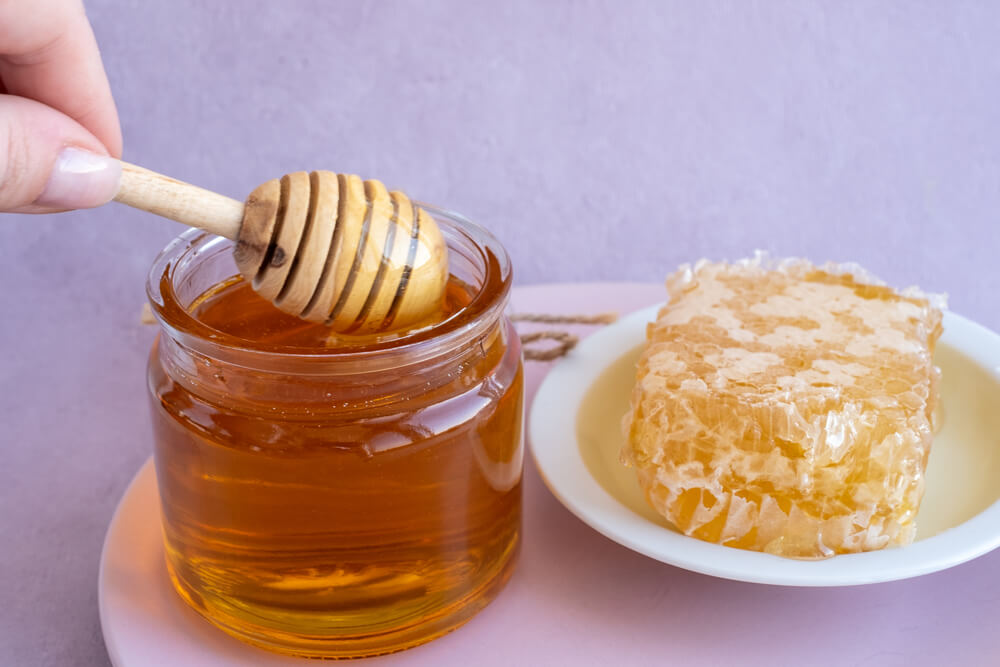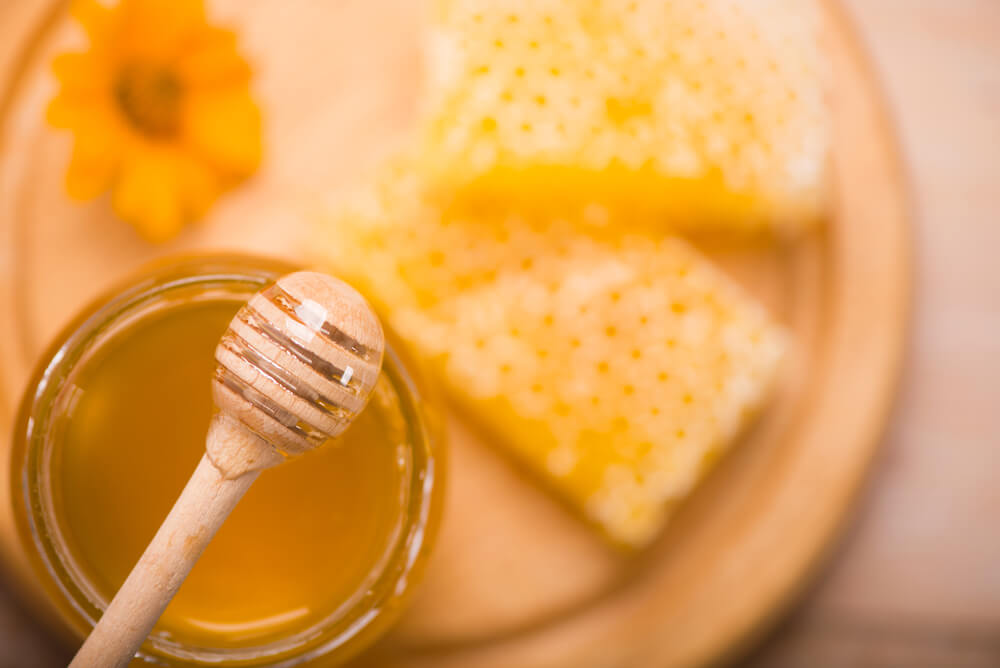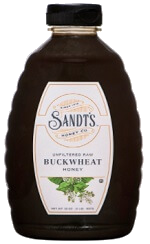Table of Contents:
What is Dark Honey?
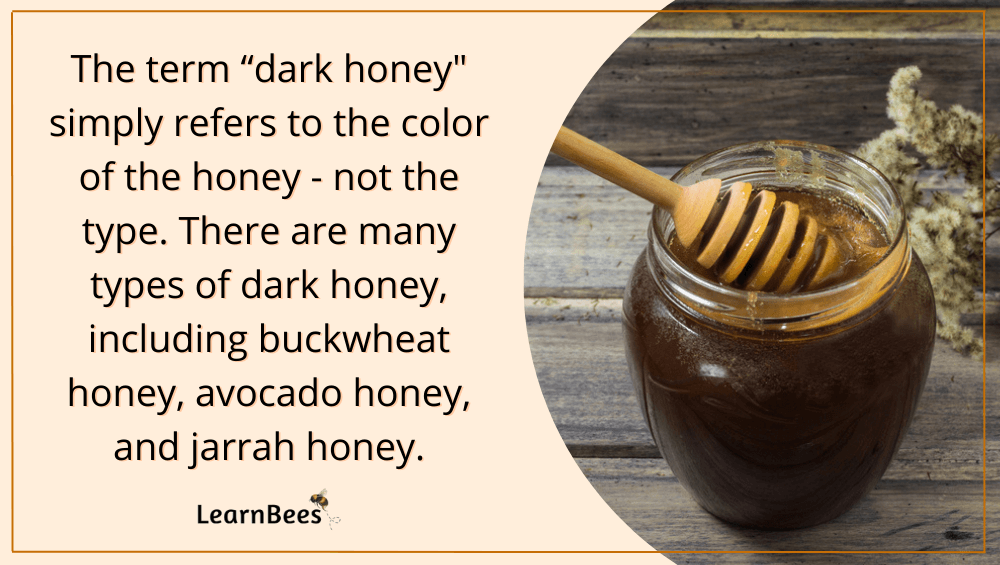
Dark honey is honey that ranges from dark amber to almost black. It’s the opposite color of light honey, which is usually light amber or even white.
The color of the honey depends on which flowers the honey bees pollinate. Certain flowers result in darker honey. For example, coffee blossoms and buckwheat blossoms are known for producing dark honey. Other flowers, like ones that come from clover trees, result in lighter honey.
Dark honey has been shown to have more bioactive plant compounds than lighter honey. It’s also been shown to have higher antioxidant levels.(1, 2, 3)
Antioxidants can help neutralize free radicals that can lead to cancer and many types of diseases. In fact, one study found that men who ate antioxidant-rich foods were less likely to develop prostate cancer.(4)
That said, lighter types like manuka honey have also been shown to come with their fair share of health benefits. So in short, dark honey isn’t necessarily healthier than light honey.
If you’re looking for health benefits, don’t pick honey based on color alone. Instead, look for labels that state the honey is “raw” and “unfiltered.”
Raw and unfiltered honey means the honey has been left in its natural state, just as the honey bees produced it. In other words, raw honey hasn’t been processed or heated to the point where it loses nutrients.
Filtered honey, on the other hand, has often been heated to the point where it loses all the enzymes, antioxidants, and nutrients that give it benefits.(5, 6, 7)
The FDA has stated that ultra-filtered honey is no longer considered real honey. Because not only are the health benefits processed out, but additives like high fructose corn syrup are put in.(8)
So no matter what color honey you purchase, just ensure that your label says “raw” and “unfiltered.” That way, you’ll enjoy the flavor of raw honey while getting the benefits.
What Are the Benefits of Dark Honey?
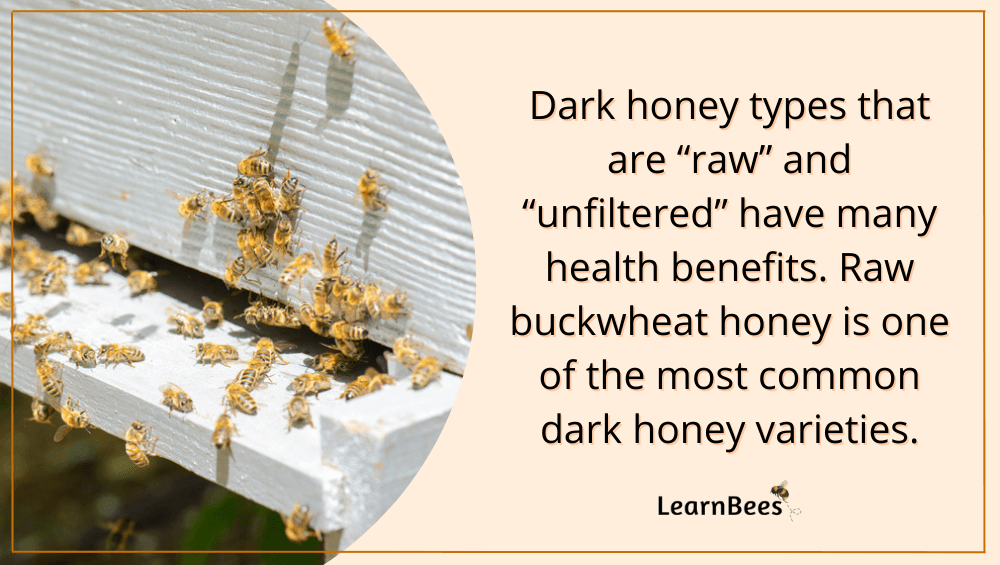
Some types of dark honey—like the buckwheat variety—have been extensively studied in clinical settings, making buckwheat honey one of the most popular types of dark honey. For example, one benefit of buckwheat honey is that it has been shown to increase the antioxidant value of your blood.(9, 10)
Buckwheat honey also has a slew of other health benefits, including:
- It can help lower your blood pressure(11, 12 )
- It can heal wounds like cuts and burns because it’s antibacterial(13, 14)
- It can improve your cholesterol levels(15, 16)
- It can reduce elevated triglyceride levels, which is a risk factor for heart disease(17, 18)
With that in mind, raw buckwheat honey may be a good option if you’re looking for dark honey. Buckwheat honey has been extensively studied in clinical trials and has been shown to be good for your skin and overall health.
What Does Dark Honey Taste Like?
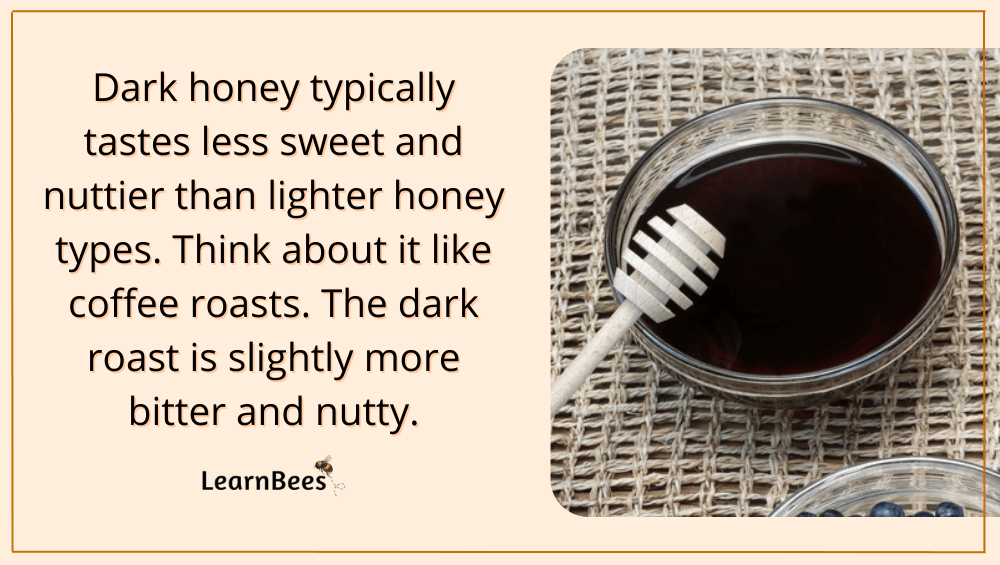
Dark honey typically has a stronger flavor than lighter types of honey. It’s usually less sweet and has an earthy, nutty undertone. Think about it like coffee roasts. The dark roast is slightly more bitter and nutty.
As a result, some people consider dark honey to be an acquired taste.
Here are 3 types of dark honey:
1. Buckwheat Honey
Buckwheat honey is made by bees who pollinate buckwheat flowers. This dark honey is native to North America, especially in New York, Pennsylvania, and Ohio.(19, 20)
Buckwheat honey is one of the darkest types of honey. Sometimes it looks almost black in the jar. Typically buckwheat honey is less sweet than other types of honey, and it has an earthy and natural undertone. Some people call it a mix between honey and molasses.
2. Avocado Honey
Avocado honey is made by bees who pollinate avocado blossoms. It’s primarily native to Mexico, Central America, California, and Australia.(21, 22)
Avocado honey doesn’t taste like avocados. It has a rich, buttery taste that mixes well with tea or coffee. It tastes similar to molasses but without the bitter notes. The color ranges from dark amber to almost black.
3. Jarrah Honey
Jarrah honey is made by bees who pollinate jarrah trees. This honey is native to Western Australia, which means it’s very rare.(23)
This honey can range from medium to dark amber. Jarrah honey is a sweeter type of dark honey. It has a sweet caramel-like flavor with a hint of nuttiness to it. The texture is smooth and creamy, and it pairs well with toast, muffins, or tea.
FAQs About Dark Honey
- Is dark honey or light honey better for allergies?
- What is dark honey called?
- Is dark honey better for you?
- Where do I buy dark honey?
- What does it mean when honey is dark?
- What’s the difference between dark honey and regular honey?
- Is dark honey considered safe?
- What foods can I pair dark honey with?
- Does dark honey expire?
- How should I store dark honey?
Is dark honey or light honey better for allergies?
The research is mixed on whether honey actually helps with allergies. One study found that honey eaten at high doses did improve a person’s allergy symptoms over eight weeks.(24)
However, another study found that honey had no effect on allergy symptoms when given to two groups.(25)
That said, both of these studies featured small sample sizes. More research is needed to determine if dark honey (or any type of honey) can help with allergies.
—> Click here to go back to the FAQs
More to Explore:
What is dark honey called?
There are more than 300 unique types of honey. So the term “dark honey” is just a vague color descriptor. It can refer to buckwheat honey, jarrah honey, avocado honey, or others. These types of honey are usually very dark in color.
Remember:
Honey can vary in color from white to almost black. The color depends on where the bees pollinate. For example, buckwheat flowers tend to produce very dark-colored honey. Clover flowers, on the other hand, can produce white honey.
If someone uses the term dark honey, just be sure to ask them which type of honey they’re talking about specifically.
—> Click here to go back to the FAQs
More to Explore:
- What is Longan Honey?
- What is Blueberry Honey?
- Allergic to Honey: Signs of a Honey Allergy + Treatment
Is dark honey better for you?
“Is darker honey healthier?” and “Is dark honey better than light honey?” are common questions we get.
All honey contains health benefits as long as it’s raw and unfiltered. But, once the honey has been processed and overly filtered, it loses the benefits that make honey a superfood.
Considering this, dark honey varieties like buckwheat have been shown to have more antioxidants than other types of lighter honey.
Buckwheat honey has also been shown to have higher bioactive plant compounds. According to Cancer.gov, bioactive plant compounds promote better health. They’re currently being studied in the prevention of cancer and various diseases.(26)
—> Click here to go back to the FAQs
More to Explore:
Where do I buy dark honey?
Dark honey can be found at your local farmer’s market or health food store, depending on where you live. If you don’t have a good farmer’s market near you and you’re wondering where to buy dark honey, try online.
—> Click here to go back to the FAQs
More to Explore:
What does it mean when honey is dark?
This is often asked alongside, “What kind of honey is dark?”
The color of your honey depends on where the bees pollinate. Certain flowers, like buckwheat and jarrah blossoms, produce darker honey. More specifically, the USDA divides honey colors into seven categories:(27)
- Water white
- Extra white
- White
- Extra light amber
- Light amber
- Amber
- Dark amber
In addition to the flowers that the bees pollinate, other factors contribute to the color of dark honey. For example, the time of year the honey is produced, and the climate can affect the color.
If your honey is dark, it doesn’t mean it’s gone bad. In fact, when stored correctly, honey never expires.(28, 29)
Even if your honey has crystallized, it’s still good. You can easily learn how to decrystallize honey so you don’t have to throw it out.
—> Click here to go back to the FAQs
More to Explore:
What’s the difference between dark honey and regular honey?
Remember, there are more than 300 unique honey varieties. For example, popular types of honey include:
You can even find these honey flavors still intact inside their honeycomb. Eating honeycombs is a delicious way to enjoy pure honey straight from the hive. The term “regular honey” is vague and doesn’t point to one type of honey. But as long as you’re choosing raw and unfiltered honey, you can’t go wrong.
—> Click here to go back to the FAQs
More to Explore:
Is dark honey considered safe?
Yes, eating honeycombs and honey is considered safe for most people over the age of one. Babies under 12 months old should not be given honey. It can contain spores that lead to infant botulism. Infant botulism can cause muscle weakness, weak cries, and problems breathing in babies.(30, 31, 32)
—> Click here to go back to the FAQs
More to Explore:
- Acacia Honey: The Taste, Health Benefits, & Risks
- Do Honey Pasteurization Ruin Honey?
- 8 Scientific Benefits of Raw Honey
What foods can I pair dark honey with?
In addition to the question, “What is the taste of dark honey?” we often get asked what to eat it with. Dark honey pairs well with cheese, wine, and crackers. It also complements pancakes, waffles, or anything that syrup would.
—> Click here to go back to the FAQs
More to Explore:
Does dark honey expire?
When stored correctly, honey never expires. Honey is hygroscopic, which means it has very little moisture in it. Bacteria and microorganisms don’t thrive in content with very little moisture.(33, 34)
Honey is also acidic because its pH ranges from 3.4 to 6.1. This acidic level also helps prevent bacteria.(35)
—> Click here to go back to the FAQs
More to Explore:
How should I store dark honey?
The best way to store dark honey (or any honey) is at room temperature, with the lid sealed tightly to prevent moisture from creeping in. Avoid storing your honey in the refrigerator or freezer. It isn’t necessary and will also cause your honey to crystallize fast.
That said, honey naturally crystallizes over time. This doesn’t mean it has gone bad. It’s just gone into a solid form. You can easily learn how to decrystallize honey in three easy steps.
